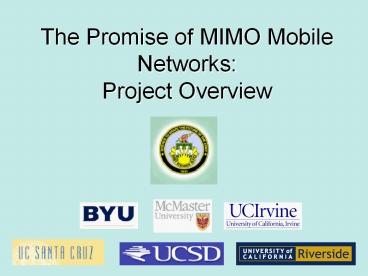The Promise of MIMO Mobile Networks: Project Overview PowerPoint PPT Presentation
1 / 11
Title: The Promise of MIMO Mobile Networks: Project Overview
1
The Promise of MIMO Mobile NetworksProject
Overview
2
MIMO
- Why MIMO?
- Potential for significantly increased channel
capacity - With rich scattering, parallel spatial channels
increase the effective bandwidth and hence
achievable bit rate. - Mathematically, this is visible through the SVD
(singular value decomposition) of the spatial
channel matrix H where rHt.
3
Spectral Efficiency
IEEE 802.11 (a) or Hiperlan/2
4
Mobile Broadband Wireless Access Standards
(802.20)
5
Spectral Efficiency
Technology Bandwidth Waveform throughput per cell spectral efficiency (b/s/Hz/cell)
WCDMA 3.84 MHz 900 kbps 0.23
cdma2000 1xEV 1.25 MHz DS SS 530 kbps 0.42
Mobile Broadband Wireless Access (802.20) 1.25 MHz Frequency Hopped OFDM gt 1.25 Mbps gt 1
Joint Tactical Radio System Narrowband WF 25 KHz 8-ary CPM 50 kbps 2
Wideband WF 150 KHz - 10 MHz OFDM 13.74 Mbps 2.7
Source Qualcomm white paper, The economics
of mobile wireless data
6
OFDM Spectrum
OFDM Spectrum
Subcarrier Spectra
Frequency Synchronization No Intercarrier
Interference
Frequency Offset Intercarrier Interference
7
MIMO Implementations
- Previous research on transmitter subspace
tracking approaches, open and closed loop
feedback techniques, space time coding - One example stochastic gradient approach using
feedback from the receiver to give the
transmitter channel state information - (Banister Zeidler, IEEE JSAC Special Issue on
MIMO, April 2003, IEEE Trans. Signal Processing,
March 2003, IEEE Trans. on Wireless Comm, in
press) - Approximates water-filling extracts best
channels but uses equal power/rate allocation to
maximize power delivered to receiver - Coding can be applied to each antenna element
- Space-Time coding
8
Increased Capacity/Reduced Dectectability Using
Multiple Antennas
Mean Capacity (bits/sec/Hz)
MIMO Optimal Water Filling MIMO Optimal Subspace
Tracking MIMO Gradient Adp. Subsp. Trkg (V.
1) MIMO Gradient Adp. Subsp. Trkg (V. 2) MIMO
Blind Transmission Single Input/Multiple Output
(SIMO) Single Input/Single Ouptput(SISO) SISO AWGN
Shannon limit for SISO
Normalized (dB)
Capacity vs. Energy Per Bit, 8 Transmit and 2
Receive Antennas
9
Current Research Issues
- Determining Channel State Information in Mobile
Networks - Open/Closed Loop Implementations
- Performance in Multi-User Networks
- Performance with Multi-Cellular Networks
- Performance in Ad-Hoc Networks
10
MURI BAA for Space Time Processing for Tactical
Mobile Ad-Hoc Networks
- Objective
- Develop cross-layer, energy-efficient
MIMO signal processing - algorithms for mobile, multi-user
ad-hoc networks employing - directional antenna arrays and STC for
tactical applications - Physical Layer
- Medium Access Control (MAC) Layer
- Networking Layer
- Signaling issues
- BF vs. STC tradeoff
- CSI estimation in interference-limited
environment
- MIMO CSI in MAC protocols
- Transmission-rate adaptability, beamforming,
location info - Transmission scheduling in context of STC
- Energy efficiency
- MAC scheduling, generated traffic, STC/BF to
reduce signaling - overhead, improve robustness and probability
of intercept
11
MURI Project Team
- University of California, San Diego
- James Zeidler (PI), Larry Milstein, Rene Cruz,
- John Proakis, Bhaskar Rao, Michele Zorzi
- University of Califnia, Irvine
- Hamid Jafarkhani
- University of California, Santa Cruz
- JJ Garcia-Luna
- University of California, Riverside
- Srikanth Krisnamurthy, Yingbo Hua
- Brigham Young University
- Lee Swindlehurst, Mike Jensen
- McMaster University
- Simon Haykin

